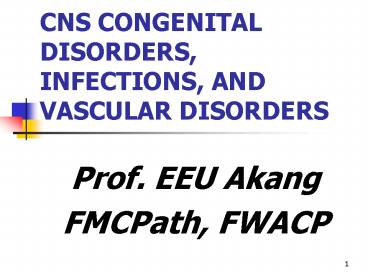CNS CONGENITAL DISORDERS, INFECTIONS, AND VASCULAR DISORDERS - PowerPoint PPT Presentation
1 / 47
Title:
CNS CONGENITAL DISORDERS, INFECTIONS, AND VASCULAR DISORDERS
Description:
Aggregate to form amyloid plaques ... Gliosis and kuru type amyloid plaques. Pathology. Human Transmissible Spongiform Encephalopathies ... – PowerPoint PPT presentation
Number of Views:762
Avg rating:3.0/5.0
Title: CNS CONGENITAL DISORDERS, INFECTIONS, AND VASCULAR DISORDERS
1
CNS CONGENITAL DISORDERS, INFECTIONS, AND
VASCULAR DISORDERS
- Prof. EEU Akang
- FMCPath, FWACP
2
Canst thou not minister to a mind diseasd,
rase out the written troubles of the brain and
with some sweet oblivious antidote, purge the
memory of that perilous stuff, which weighs upon
the brain.William Shakespeare, MACBETH
3
CENTRAL NERVOUS SYSTEM
- Complex- 2 TBW, 50 of genomic DNA
- Protective bony case
- Autoregulation- 25 of cardiac output
- No lymphatics
- CSF circulation
- Limited immune surveillance
- Metabolic substrate requirements
4
MENINGES
- Three membranes
- Dura mater
- Arachnoid mater
- Pia mater
- Three spaces
- Epidural
- Subdural
- Subarachnoid (contains CSF)
5
CELLS- NEURONS
- Topographically organised
- Differ in terms of function, metabolism,
neurotransmitters, etc. - ACUTE INJURY (Red neuron)
- CHRONIC INJURY (Degeneration)
- AXONAL REACTION
- INCLUSIONS (lipofuscin, viral)
- DEPOSITS (NFT, Pick bodies, Lewy bodies)
6
CELLS- GLIA
- ASTROCYTES- Gliosis, Cellular swelling, Rosenthal
fibres, corpora amylacea - OLIGODENDROCYTES- Demyelination (Multiple
sclerosis, PML) - EPENDYMAL CELLS- ependymal granulations (CMV)
- MICROGLIA- rod cells, microglial nodules,
neuronophagia
7
CONGENITAL MALFORMATIONS- 1
- 1-20 of post neonatal deaths
- CAUSES
- Idiopathic (40-60)
- Multifactorial (20-25)
- Chromosomal- (10-15)
- Mendelian- (2-10)
- Maternal disease- (6-8)
- Transplacental infection- (2-3)
8
CONGENITAL MALFORMATIONS- 2
- NEURULATION- wk 3 (anencephaly, spina bifida)
- TELENCEPHALISATION- wk 5-6 (arrhinencephaly,
holoprosencephaly) - MIGRATION- 2-5 mos (micrencephaly, lissencephaly
(Miller-Dieker syndrome), pachygyria,
polymicrogyria, heterotopia) - MATURATION- 3rd trim.-post natal (megalencephaly,
Arnold-Chiari, Dandy-Walker)
9
ANENCEPHALY
10
MYELOMENINGOCELE
11
HOLOPROSENCEPHALY
12
CNS INFECTIONS- INTRODUCTION
- Primary problem in tropical neurology
- No lymphatics
- Blood-brain barrier
- Bony casing
12
13
ROUTES OF ACQUISITION OF CNS INFECTION
- HAEMATOGENOUS (pleuro-pulmonary, septicaemia)
- IMPLANTATION (fracture, VP shunt, craniotomy, LP)
- LOCAL EXTENSION (otitis, sinusitis, mastoiditis,
s. bifida) - ALONG NERVES (rabies, zoster)
13
14
CELLULAR TROPISMS OF INFECTIVE AGENTS IN CNS
- Poliomyelitis virus (anterior horn cells)
- Rabies virus (hippocampus, Purkinje cells)
- JC virus (oligodendrocytes)
- Cytomegalovirus (ependyma)
14
15
MENINGITIS- CLASSIFICATION TYPES
- Pachymeningitis- trauma, TB
- Leptomeningitis-
- BACTERIAL
- TUBERCULOUS
- FUNGAL
- VIRAL
- PROTOZOAN
- HELMINTHIC
15
16
(No Transcript)
17
(No Transcript)
18
Gram-negative intracellular diplococci- N.
meningitides
19
TUBERCULOUS MENINGITIS Note the basal exudate
20
INDIA INK PREPARATION Cryptococcus neoformans
21
MENINGITIS- COMPLICATIONS
- Subdural effusion
- Cranial nerve palsy
- Vasculitis
- Abscess
- Hydrocephalus
- Mental retardation
- Seizures
- Waterhouse-Friederichsen syndrome
- SIADH
21
22
BRAIN ABSCESS
23
TONSILLAR HERNIATION
24
UNCAL HERNIATION
25
CINGULATE (SUBFALCINE) HERNIATION
26
DURET HAEMORRHAGE- UPPER PONS
27
VIRAL ENCEPHALITIS
- Perivascular lymphocytes and plasma cells
- Neuronophagia
- Microglial nodules
- Inclusions
- 1. cytoplasmic- Negri bodies of rabies,
- 2. nuclear- HSV, VZV, measles, CMV
27
28
SLOW VIRUS INFECTIONS
- SUBACUTE SCLEROSING PANENCEPHALITIS- Measles
- PROGRESSIVE MULTIFOCAL LEUKOENCEPHALOPATHY- JC
virus - PROGRESSIVE RUBELLA ENCEPHALOPATHY- Rubella
28
29
Prions
- Proteinaceous infectious particles
- Lack DNA and RNA
- Aggregate to form amyloid plaques
- Transmitted by intracerebral, intraperitoneal,
intravenous, corneal and oral routes - Hereditary and sporadic diseases
- Stanley Prusiner (1997 Nobel Prize)
29
30
THE CENTRAL DOGMA
- DNA
- RNA
- Protein
30
31
PRIONS
- Single 250 amino acid molecules
- Abnormal variants of normal neuronal
sialoglycoproteins. - Normal PrPc (protease sensitive)
- PrPres (protease resistant)
- PrPres promotes further conversion of PrPc to
PrPres
31
32
Spongiform encephalopathy
- Pathology
33
Gliosis and kuru type amyloid plaques
- Pathology
34
Human Transmissible Spongiform Encephalopathies
- Creutzfeldt-Jakob Disease (CJD)
- Gerstmann-Straussler-Scheinker disease
- Fatal familial insomnia
- Alpers disease (infants)
- PrP Cerebral amyloid angiopathy
- Kuru
35
Cerebral Malaria
- Coma 6- 96 hours
- shorter in children
- 20 fatality
- Hepatosplenomegaly common
- Retinal haemorrhages
- Oedematous, slate grey brain
- Petechial haemorrhages in white matter
- Ring haemorrhages
- Dürck granulomas (microglial clusters)
35
36
Cerebral Malaria
36
37
Brain section - P. falciparum
37
38
CEREBRAL VASCULAR DISORDERS
- Transient ischaemic attacks- Focal transient
neurological deficits lasting lt1hr - Stroke- Focal permanent neurological deficit
- HAEMORRHAGIC-
- Intracerebral haemorrhage (10)
- Subarachnoid haemorrhage (15)
- ISCHAEMIC- Thrombotic (60)
- Embolic (15)
38
39
STROKE- Risk Factors
- Hypertension
- Atherosclerosis
- Cigarette smoking
- Alcohol
- Elderly age
- Male sex
- Black race
39
40
ACUTE RT. SIDED CEREBRAL INFARCT
41
REMOTE RT. SIDED CEREBRAL INFARCT
42
HYPERTENSIVE INTRACEREBRAL HAEMORRHAGE
43
ARTERIOVENOUS MALFORMATION
44
TRAUMATIC INTRACRANIAL HAEMORRHAGE
- EPIDURAL- Middle meningeal artery
- SUBDURAL- Bridging veins
- SUBARACHNOID- Circle of Willis, intracerebral
haemorrhage extension - INTRACEBREBRAL
44
45
EPIDURAL HAEMORRHAGE
46
SUBDURAL HAEMORRHAGE
47
Chance favours the prepared mind.Louis Pasteur































